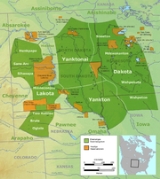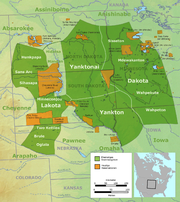
Standing Rock Indian Reservation
Encyclopedia

Sioux
The Sioux are Native American and First Nations people in North America. The term can refer to any ethnic group within the Great Sioux Nation or any of the nation's many language dialects...
Indian reservation
Indian reservation
An American Indian reservation is an area of land managed by a Native American tribe under the United States Department of the Interior's Bureau of Indian Affairs...
in North Dakota
North Dakota
North Dakota is a state located in the Midwestern region of the United States of America, along the Canadian border. The state is bordered by Canada to the north, Minnesota to the east, South Dakota to the south and Montana to the west. North Dakota is the 19th-largest state by area in the U.S....
and South Dakota
South Dakota
South Dakota is a state located in the Midwestern region of the United States. It is named after the Lakota and Dakota Sioux American Indian tribes. Once a part of Dakota Territory, South Dakota became a state on November 2, 1889. The state has an area of and an estimated population of just over...
in the United States
United States
The United States of America is a federal constitutional republic comprising fifty states and a federal district...
. The sixth-largest reservation in land area in the United States, it comprises all of Sioux County, North Dakota
Sioux County, North Dakota
-Demographics:As of the census of 2000, there were 4,044 people, 1,095 households, and 871 families residing in the county. The population density was 4 people per square mile . There were 1,216 housing units at an average density of 1 per square mile...
, and all of Corson County, South Dakota
Corson County, South Dakota
As of the census of 2000, there were 4,181 people, 1,271 households, and 949 families residing in the county. The population density was 1.7 people per square mile . There were 1,536 housing units at an average density of 0.6 per square mile...
, plus slivers of northern Dewey County
Dewey County, South Dakota
As of the census of 2000, there were 5,972 people, 1,863 households, and 1,386 families residing in the county. The population density was 3 people per square mile . There were 2,133 housing units at an average density of 1 per square mile...
and Ziebach County
Ziebach County, South Dakota
As of the census of 2000, there were 2,519 people, 741 households, and 594 families residing in the county. The population density was 1.3 people per square mile . There were 879 housing units at an average density of 0.4 per square mile...
in South Dakota, along their northern county lines at Highway 20
South Dakota Highway 20
South Dakota Highway 20 is a state route that largely runs from border to border across the northern part of the U.S. state of South Dakota that consists of two segments. The longer segment begins at the Montana border west of Camp Crook, and terminates at the junction of U.S. Highway 212 in...
.
The reservation has a land area of 9251.183238 square kilometres (3,571.9 sq mi) and a population of 8,250 as of the 2000 census. The largest communities on the reservation are Cannon Ball
Cannon Ball, North Dakota
Cannon Ball is a census-designated place in Sioux County, North Dakota in the United States and on the Standing Rock Indian Reservation. It sits in the northeastern part of Sioux County where the Cannonball River meets Lake Oahe of the Missouri River...
, Selfridge
Selfridge, North Dakota
Selfridge is a city in Sioux County, North Dakota in the United States and on the Standing Rock Indian Reservation. Selfridge was founded in 1911. The population was 160 at the 2010 census...
, and McLaughlin
McLaughlin, South Dakota
McLaughlin is a city in Corson County, South Dakota, United States. The population was 663 at the 2010 census. It is the largest city on the Standing Rock Indian Reservation.-History:...
.Other communities within the reservation include
Bullhead
Bullhead, South Dakota
Bullhead is a census-designated place in Corson County, South Dakota, United States. The population was 348 at the 2010 census.-Geography:Bullhead is located at ....
,
Fort Yates
Fort Yates, North Dakota
Fort Yates is a city in Sioux County, North Dakota in the United States. It is the tribal headquarters of the Standing Rock Sioux Tribe and county seat of Sioux County...
,
Kenel,
Little Eagle
Little Eagle, South Dakota
Little Eagle is a census-designated place in Corson County, South Dakota, United States. The population was 319 at the 2010 census.-Geography:Little Eagle is located at ....
,
Porcupine
Porcupine, North Dakota
Porcupine is a census-designated place in Sioux County, North Dakota, United States. It lies only a few minutes' drive from the city of Selfridge. The community includes the headquarters of the Selfridge/Porcupine district....
, and
Wakpala
Wakpala, South Dakota
Wakpala is an unincorporated community in Corson County, South Dakota, United States. Although not tracked by the Census Bureau, Wakpala has been assigned the ZIP code of 57658. Wakpala is within the boundaries of the Standing Rock Indian Reservation and its name loosely translates to "creek" in...
.
Background
The Yanktonai and Dakota live in North Dakota, the Lakota live in South Dakota. Thunder ButteThunder Butte
Thunder Butte is a prominent butte landmark located in the northwest corner of Ziebach County, South Dakota, in the United States...
, a prominent landmark, is along the border between the Standing Rock Reservation and the Cheyenne River Indian Reservation
Cheyenne River Indian Reservation
The Cheyenne River Indian Reservation was created by the United States in 1889 by breaking up the Great Sioux Reservation, following its victory over the Lakota in a series of wars in the 1870s. The reservation covers almost all of Dewey and Ziebach counties in South Dakota...
. The latter is occupied by the Cheyenne River Lakota Nation.
Sitting Bull
Sitting Bull
Sitting Bull Sitting Bull Sitting Bull (Lakota: Tȟatȟáŋka Íyotake (in Standard Lakota Orthography), also nicknamed Slon-he or "Slow"; (c. 1831 – December 15, 1890) was a Hunkpapa Lakota Sioux holy man who led his people as a tribal chief during years of resistance to United States government policies...
was a highly respected Lakota war chief and medicine man
Medicine man
"Medicine man" or "Medicine woman" are English terms used to describe traditional healers and spiritual leaders among Native American and other indigenous or aboriginal peoples...
who led the Lakota in years of resistance to the United States in the late 19th century. He commanded forces that defeated General George Armstrong Custer
George Armstrong Custer
George Armstrong Custer was a United States Army officer and cavalry commander in the American Civil War and the Indian Wars. Raised in Michigan and Ohio, Custer was admitted to West Point in 1858, where he graduated last in his class...
at the Battle of the Little Bighorn
Battle of the Little Bighorn
The Battle of the Little Bighorn, also known as Custer's Last Stand and, by the Indians involved, as the Battle of the Greasy Grass, was an armed engagement between combined forces of Lakota, Northern Cheyenne and Arapaho people against the 7th Cavalry Regiment of the United States Army...
in 1876. His grave is on the reservation. Sitting Bull College
Sitting Bull College
Sitting Bull College is a tribal college in Fort Yates, North Dakota. It was founded in 1973 by the Standing Rock Sioux tribe of the Standing Rock reservation in south-central North Dakota. It is one of 34 tribally controlled colleges nationwide. It is also a member of the American Indian Higher...
was named in his honor. His people, the Hunkpapa
Hunkpapa
The Hunkpapa are a Native American group, one of the seven council fires of the Lakota Sioux tribe. The name Húŋkpapȟa is a Sioux word meaning "Head of the Circle"...
(Húŋkpapȟa), mainly reside on this reservation. Húŋkpapȟa means "Head of the Circle", due to the tradition of their setting their lodges at the entryway to the circle during Sioux council.
Originally with a territory of 4 million acres (16,187.4 km²) in 1864, the reservation was reduced in size after the Indian Wars of the 19th century, resulting in more land available for European-American settlers.
University of North Dakota
The athletic teams of the University of North DakotaUniversity of North Dakota
The University of North Dakota is a public university in Grand Forks, North Dakota, USA. Established by the Dakota Territorial Assembly in 1883, six years before the establishment of the state of North Dakota, UND is the oldest and largest university in the state and enrolls over 14,000 students. ...
(UND) are known as the Fighting Sioux
North Dakota Fighting Sioux
The North Dakota Fighting Sioux are the athletic teams of the University of North Dakota , which is located in the city of Grand Forks, North Dakota, in the United States. The logo is a Native American figure. The logo was designed by Bennett Brien, a local artist and UND graduate of Ojibwa...
. Controversy surrounding the use of Native American mascots
Native American mascot controversy
The propriety of using Native American mascots and images in sports has been a topic of debate in the United States and Canada since the 1960s.Americans have had a history of drawing inspiration from native peoples and "playing Indian" that dates back at least to the 18th century...
prompted the NCAA
National Collegiate Athletic Association
The National Collegiate Athletic Association is a semi-voluntary association of 1,281 institutions, conferences, organizations and individuals that organizes the athletic programs of many colleges and universities in the United States...
to ban the use of "hostile and abusive" Native American mascots in August 2005. An exception was made to allow the use of tribal names as long as approved by that tribe. Since the Tribal Council of the Standing Rock Sioux have not approved UND's use of "Fighting Sioux", the ban prevents the university from hosting any championships and disallows the use of UND's team logo or nickname at any championship events. The North Dakota Legislative Assembly
North Dakota Legislative Assembly
The North Dakota Legislative Assembly is the state legislature of the U.S. state of North Dakota. The Legislative Assembly consists of two chambers, the lower North Dakota House of Representatives, with 94 representatives, and the upper North Dakota Senate, with 47 senators...
raised the stakes during its 62nd session by passing House Bill No. 1263, which declares "The intercollegiate athletic teams sponsored by the University of North Dakota shall be known as
the University of North Dakota Fighting Sioux....If the National Collegiate Athletic Association takes any action to penalize the University of North Dakota for using the Fighting Sioux nickname or logo, the attorney general
North Dakota Attorney General
The North Dakota Attorney General is the chief legal officer of the North Dakota state government. The current Attorney General is Wayne Stenehjem...
shall consider filing a federal antitrust claim against that association."

